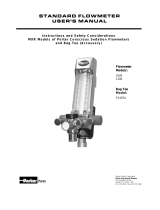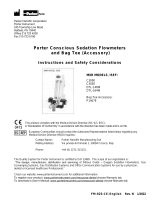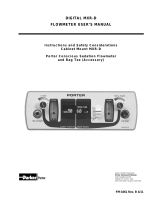Page is loading ...

The Porter Floor Mounted Outlet Station is
manufactured of durable, satin-finished aluminum
with a color coded faceplate to provide instant gas
identification. The station’s compact size (less
than three inches high) allows for a clean,
unobtrusive installation. Features include the
cross+protection system to prevent unintentional
misconnection to the central piping system. The
outlet station utilizes a duplex connector which
prevents the Nitrous Oxide from being connected
unless the Oxygen is connected, and offers
resuscitator quick connect compatibility. A qualified
plumber can install the outlet station by following
the details listed in this brochure.
WARNING
Porter Outlet Stations utilize the cross+protection
system. The copper tubing is diameter indexed;
3⁄8"O.D. for Nitrous Oxide and 1⁄2"for Oxygen. The
cross+protection system is designed to prevent
misconnection of Oxygen and Nitrous Oxide
piping. DO NOT ATTEMPT TO CHANGE THE
DIAMETERS! Tampering with the cross+protec-
tion system constitutes acceptance of liability by
the installer.For your own protection, as well as
that of the Doctor and the patients, use 3⁄8"O.D.
tubing for all Nitrous Oxide lines and 1⁄2"O.D.
tubing for all Oxygen lines.
Toassure safe operation and conformation to
local fire codes, all Porter Outlet Stations are
designed to be used with sedation delivery
systems mounted inside walls or flooring and
they meet or exceed the guidelines established
by the National Fire Protection Association for
Nonflammable Medical Gas Systems, NFPA 99.
Copies of NFPA 99 or portions thereof may be
obtained by writing to:
National Fire Protection Association
Batterymarch Park
Quincy, MA 02269-9904
Or call: 1-800-344-3555
Model 6300-1
WARNING
Dental workers are exposed to N2Oduring
administration of N2O/O2conscious sedation
analgesia. NIOSH has recommended that
exposures should be minimized. Contact NIOSH
(1-800-35-NIOSH) to receive NIOSH Publications
on Control of Nitrous Oxide in Dental Operatories.
Exposure can be minimized by effective controls.
National Institute for Occupational Safety and
Health (NIOSH) publications state that controls,
including System Maintenance, Ventilation and
Work Practices can effectively reduce N2O
concentrations in dental operations. Your Porter
Scavenger System is an important part of the
system of controls.
PORTER
INSTRUMENT COMPANY, INC.
245 TOWNSHIP LINE RD.
P.O. BOX 907
HATFIELD, PA
19440-0907
USA
[215] 723-4000 / ] 723-2199
Nitrous Oxide / Oxygen
Floor Mounted Outlet Station
Installation and Instructions
FM-171 Rev.C10/06
Hatfield, PA 19440 USA
(215) 723-4000 / fax (215) 723-5106
D 4/13

STATION INSTALLATION
INSTRUCTIONS
1. Select and prepare appropriate location
for mounting station. See Typical Station
Mounting Plan (below) for gas supply
and base plate mounting hole locations.
Typical Station Mounting Plan
2. Install the gas lines. Note: The station is
designed and intended to be used with
gas supply lines installed using NFPA 99
guidelines, including a 150 PSI piping integrity
test. Medical grade dry Nitrogen should be
used as a “forming gas” while soldering.
To prevent oxidation inside supply lines:
(a) Use type K or L, pre-cleaned, degreased,
capped copper tubing ONLY.
(b) Use
3⁄8"O.D. for Nitrous Oxide, use 1⁄2"
O.D. for Oxygen. DO NOT CHANGE
TUBING DIAMETERS!!
(c) All copper to copper joints are to be made
using a brazing allow conforming to AWS
Classification BcuP-5 (see AWS Std.
A5.8). Flux shall not be used.
3. Remove front faceplate from Outlet Station.
4. Remove housing from base plate by sliding
Housing to rear.
5. Solder gas supply lines to Outlet Station
tubes. Solder all joints. Use silver solder or
other brazing alloy with a melting point of
1000°F or more.
6. Position base plate and mount securely to
floor with 1⁄4"diameter mounting screws or lag
bolts.
7. Slide Housing onto base plate.
8. After connecting all gas lines, check the
system for leaks with dry Nitrogen per NFPA
99, by performing a 150 psi, 24 hour piping
integrity test (5 psi drop allowed).
9. Check for crossed lines. (Refer to NFPA
Gas and Vacuum Systems Code for Level III
Systems) (See cross+protection
Warning inthis brochure.)
10. Alignment and Adjustment for Front Faceplate
Installation – The Oxygen and Nitrous Oxide
valve bodies are factory adjusted to allow for
the back of the front faceplate to press against
the metal surfaces of both valve bodies. If
adjustment is needed:
Rotate the Oxygen and Nitrous Oxide
valve bodies so they both uniformly con-
tact the back of the front faceplate when it
is installed. Oxygen has right hand threads
and Nitrous Oxide has left hand threads.
11. Install front faceplate to housing so it contacts
housing and valve bodies.
12. Connect an 8060 series duplex connector and
hoses into the completely assembled Floor
Mounted Outlet Station. Attach the other end
of the hoses to a flowmeter and turn the flow
control knobs to the off position and the on/off
switch to the off position.
13. Leak test the entire system for working
pressure leaks. Pressurize the sedation
gas supply lines with 50 PSI. Observe any
pressure decay after 12 hours. This 50 PSI
test with the flowmeter tubing connections in
place tests the seal of the duplex connector
extended into the o-rings of the outlet station
primary check valves. (5 PSI drop allowed.)
CONNECTIONS TO FLOWMETER –
OPERATING INSTRUCTIONS
Flowmeter gas supply tubing and vacuum tubing
is connected to the Outlet Station via two quick
connect couplers. The Porter 8060 series duplex
connector simultaneously connects the Oxygen
and Nitrous oxide tubing, and prevents the Nitrous
Oxide from being connected unless the Oxygen
is connected.
2

QUICK CONNECTING
You may quick connect to the station when the
system pressure is at its normal 50 PSI; the
primary check valves seal this pressure. The
coupler has a locating latch. Simply insert the
coupler into the appropriate check valve and
confirm the latch is in place behind the catch
feature of the valve. A gentle tug on the coupler
will confirm a stable latch position. Internally,
within the primary check valve, an o-ring seals
against a poppet. The same o-ring seals against
the quick connect extensions upon insertion. Slide
the latch out of position to remove the connector
and the internal poppet will automatically move
back into its sealing position.
RESUSCITATOR
Remove the duplex connector so a resuscitator
quick connect may be inserted into the Oxygen
station position.
MAINTENANCE AND SERVICE
Use Scavenging
Monitor for N2Oin the operatory to insure that
controls are effective in achieving low levels of
ppm (parts per million) exposure. Contact your
Porter dealer for details on monitors and testing.
Inspect and maintain the analgesia delivery sys-
tem to prevent N2Oleaks in all hoses, connections
and fittings. Repair all leaks immediately.
MONTHLY CHECK
Leak test the entire system for working
pressure leaks. Connect an 8060 series
duplex connector and hoses into the Outlet
Station. Attach the other end of the hoses to a
flowmeter and turn the flow control knobs to the
off position and the on/off switch to the off position.
Pressurize the sedation gas supply lines with 50
PSI. Observe any pressure decay after 12 hours.
This 50 PSI test with the flowmeter tubing
connections in place tests the seal of the duplex
connector extended into the o-rings of the outlet
station primary check valves. (5 PSI drop allowed.)
SERVICE PRIMARY AND SECONDARY
CHECK VALVE ASSEMBLIES
The Oxygen and Nitrous Oxide primary and sec-
ondary check valve assemblies may be field disas-
sembled and replaced.
1) Primary Check Valve Assembly O2A-2689-000
N2OA-2690-000
2) Cartridge Body O2B-2237-000
N2OB-2275-000
3) 016 O' Ring PB-102-215
4) Secondary Check Valve Assembly A-2699-000
5) Compression Spring PB-115-63SS
PRIMARY CHECK VALVE
DISASSEMBLY INSTRUCTIONS
SERVICE PRIMARYCHECK VALVE
May be serviced with station pressurized
to 50 PSI.
1. Remove front plate. Mounting screws are
behind plate labels.
2. Unscrew the primary check valve assembly.
Oxygen right hand threads; Nitrous Oxide left
hand threads. Note: the secondary
check valve will move into position and
seal the 50 PSI of the station pressure
as the primary check valve assembly
is removed.
WARNING
Do not remove the cartridge body while
servicing the primary check valve assembly.
The secondary check valve cannot seal the 50
PSI pressureif the cartridge body is removed.
3

4
3. Replace the entire assembly.
4.Screw the replaced assembly into the
cartridge body.
5. Alignment and Adjustment for Front Faceplate
Installation – The Oxygen and Nitrous Oxide
valve bodies are factory adjusted to allow for
the back of the front faceplate to press against
the metal surfaces of both valve bodies.
If adjustment is needed:
WARNING
To service the secondary check valve, first
turn off pressure. Do not remove the cartridge
body until the pressureis bled off. The
secondary check valve cannot seal the
50 PSI pressure if the cartridge body is
removed.
1. Turn off pressure at tanks in tank room.
2. Follow procedure to remove primary check
valve assembly.
3. Depress secondary check valve further into
station block using a small probe or screw
driver to bleed offpressure.
4. Unscrew cartridge body out of the station
block.
Rotate the Oxygen and Nitrous Oxide
valve bodies so they both uniformly
contact the back of the front faceplate.
Oxygen has right hand threads and
Nitrous Oxide has left hand threads.
6. Leak test the entire system for working
pressure leaks per the Monthly Check.
5. Take a small screw driver or needle nose
pliers and insert into holes at the center of
secondary check valve. Carefully remove
check valve and spring.
6. Replace the 016 o-ring and secondary check
valve parts as required and place in position
for reassembly.
7. Screw in the cartridge body and tighten.
8. Screw in the primary check valve assembly
and align and adjust for front plate installation.
9. Leak test the entire system for working
pressure leaks per the Monthly Check.
SECONDARY CHECK VALVE
DISASSEMBLY INSTRUCTIONS
SERVICE SECONDARY CHECK VALVE
4
/












